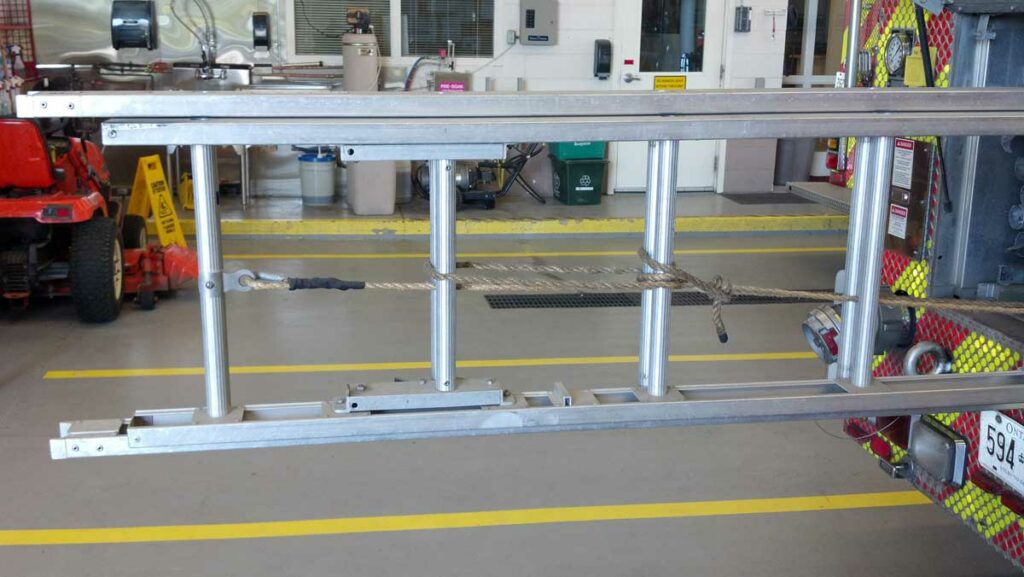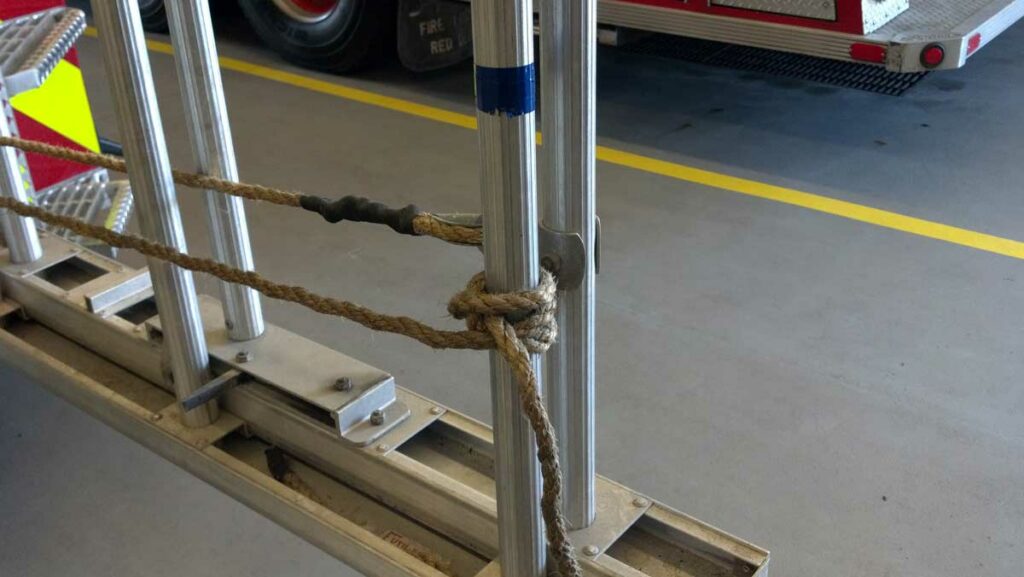The ground ladder is used for many purposes on the fireground, including rescue. Many rescues have been made using the ground ladder at a residential structure fire with just one firefighter. One firefighter armed with a 24-foot ground ladder can be effective in rescuing occupants from as high as the third story of a structure.
One of the handicaps of the ground ladder is the halyard, the piece of rope that is used to extend or retract the fly section of the ladder. The halyard is a piece of utility rope that has one primary function–to extend/retract the fly section. It is not considered to be life safety rope nor is it rated as such, and this includes the pulley and the clasp that holds the halyard to the bottom rung of the bed section. The halyard is not designed to hold the weight of both the fly section and a firefighter should the locks fail, and if the firefighter is bringing down an occupant, the halyard will certainly not hold the added weight.

On an extension ground ladder, the halyard will be tied off in a way that it secures the fly section to the bed section. As seen in photo 1, the usual knot employed is the clove hitch. It will be tied around the rungs incorporating the halyard in the middle of the knot. The clove hitch will be tied around the third or fourth rung up from the bottom of the ladder. This is the usual way of doing things, but it adds time when trying to deploy the ladder and raise it in place. The time it takes to untie the knot, unwrap the rope, and then extend it will complicate and delay the rescue operation.
RELATED FIREFIGHTER TRAINING
Training Minutes: Ground Ladder Placement

In photo 2, you can see the halyard tied around the bottom rung, but only one of the bottom rungs. The halyard is tied as a clove hitch around the rung and kept that way. Some depts will finish the knot off by splicing the tail end of the rope to the main piece of the rope. By doing this, it allows the ladder to be extended without having to untie the knot, thus saving time in the operation.
If the rope needs to be tied off after the raise, the halyard can be tied using a clove hitch on a bight. As long as the locks/pawls/dawgs are secured on the rung of the ladder, the ladder will not fail. The halyard can hang there without being tied off and the ground ladder will still do the job of providing access for the rescue and supporting the weight of both the firefighter and the occupant.
Equipment needed: 24-foot ground ladder, access to a building
Goal: To practice raising and extending a ground ladder without untying the halyard
Drill:
- Using a 24-foot ground ladder, prep it by tying the halyard around the bottom rung as pictured in photo 2.
- Using another 24-foot ground ladder, keep the halyard tied as pictured in photo 1 (the traditional way).
- Using a building equipped with a window, have one firefighter grab the traditional ground ladder to effect a window rescue. They will have to untie the halyard prior to extending the ladder in position. Time this scenario.
- Using the other ground ladder (halyard tied to bottom rung), have the same firefighter compete the scenario again. Time this scenario.
- Repeat the same drill with each firefighter on the crew to show the time/practical differences between the two.
Key points:
- Save time with a rescue operation by keeping the halyard tied to the bottom rung of the ladder.
- The halyard is nothing more than a piece of utility rope, not life safety rope.

Mark van der Feyst has been in the fire service since 1999 and is a firefighter with the Fort Gratiot (MI) Fire Department. He is an international instructor teaching in Canada, the United States, and India, and at FDIC. He is also the lead author of Residential Fire Rescue (Fire Engineering Books & Video). He can be contacted at Mark@FireStarTraining.com.
MORE MARK VAN DER FEYST
Firefighting Basics: Aggressive Cooling and Vertical Ventilation
Go High: Rungs Above the Roofline
Firefighting Basics: Aggressive Cooling and Preflashover Conditions
Firefighter Training Drill: Reverse Hold of Pike Pole or Roof Hook

